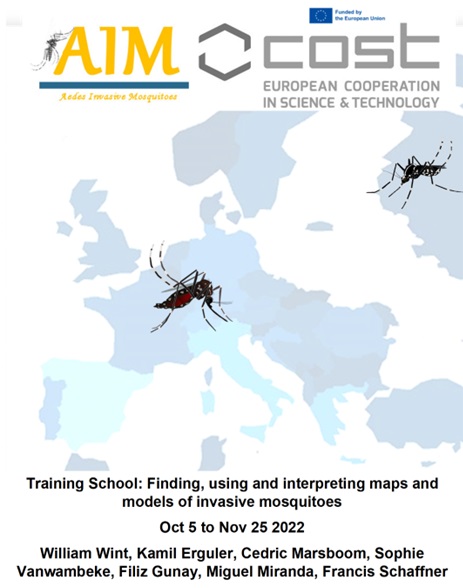3rd AIM-COST Training School "Finding, using and interpreting maps and models of invasive mosquitoes

Training School Objectives
The workshop was a combination of virtual and face-to-face sessions; and was focused on five objectives:
- To teach participants how to interpret available maps, models, and sampling results relating to invasive mosquitoes;
- To use this knowledge to evaluate information available for their region, identify gaps, and propose solutions to fill the gaps;
- To prepare a presentation on their assessments of the situation in their region.
- To use this knowledge to evaluate information available for their region, identify gaps, and propose solutions to fill the gaps;
- To prepare a presentation on their assessments of the situation in their region.
A report on the workshop with links to all the training material and presentations are available here in PDF and Word formats.
This training is NOT, therefore, aimed at experienced mappers and modellers, but at those who need to use and interpret maps and models rather than produce them, such as Public Health professionals, field staff, and students.
The training school was divided into three sessions - an introductory virtual session, a face-to-face day to provide some theoretical overviews and begin the process of preparing the presentations, and a second virtual session to make the presentations. Trainees were asked to form regional teams to collaborate between the face-to-face day and the second virtual session to finalise and produce the required presentation. Further details are given below.
Training School Sessions
- 5th October 1100-1315 CET Online. This introductory session have outlined the training school objectives and practicalities, provide an overview of AIM-COST recommendations for surveillance and modelling best practice, and provide details of the way to use maps and models to communicate data and results to a range of stakeholders. The trainees have also been asked to arrange themselves into small regional teams ready to participate in the Face to Face day the following week.
- Face to Face day Monday 10th October, the day before the start of the ESOVE conference. Location: Sofia Hotel Balkan, SOFIA, Bulgaria. This face-to-face training day consisted of two parts - a series of lecture sessions in the morning designed to give trainees an overview of mapping and modelling methods, focusing on what can be done and what cannot be done with these techniques, and illustrating how model and map outputs can be best produced and interpreted. The afternoon sessions concentrated on helping the participants evaluate the data about invasive mosquitos available at the continental scale and for their region, and starting the process of preparing presentations to be given online in November.
- Presentation of Results. Online, on a date in November or December to be decided at the Face to Face day in Sofia. The trainee teams presented their evaluation and analysis of the information about invasive mosquitos available for their region, identifying any gaps, specifying what additional information is needed to feed surveillance, control, and policy decisions, and describing how such information should be obtained. Each presentation was followed by an open discussion and feedback on potential changes or improvements that could be made. The presentations were evaluated, and the team giving the presentation with the highest score was asked to present their findings at the AIM-COST Annual Meeting in Rome on Feb 2023.
Download information and further information on session topics here.
Please note that participants/applicants were restricted to the following COST Countries: Albania, Austria, Belgium, Bosnia and Herzegovina, Bulgaria, Croatia, Cyprus, Czech Republic, Denmark, Estonia, Finland, France, Georgia, Germany, Greece, Hungary, Iceland, Ireland, Italy, Latvia, Lithuania, Luxembourg, Malta, the Republic of Moldova, Montenegro, The Netherlands, The Republic of North Macedonia, Norway, Poland, Portugal, Romania, Serbia, Slovakia, Slovenia, Spain, Sweden, Switzerland, Turkey, Ukraine, and United Kingdom. The Cooperating Member is Israel and the Partner Member is South Africa. ...and NNC countries: Algeria, Armenia, Azerbaijan, Belarus, Egypt, Georgia, Jordan, Kosovo, Lebanon, Libya, Morocco, the Palestinian Authority, Syria, Tunisia.
Trainers
Kamil Erguler, Climate and Atmosphere Research Center (CARE-C), The Cyprus Institute, Cyprus. Modelling climate impacts on vector-borne diseases.
Neil Alexander, Environmental Research Group Oxford, ℅ Department of Zoology, University of Oxford, UK. Geographic data management and analysis.
Cedric Marsboom, Research department, Avia-GIS, Zoersel, Belgium. Spatial and mathematical modelling.
Filiz Gunay, Vector Ecology Research Group, Biology Department, Ecology Section, Hacettepe University, Turkey. Vector data collection and efforts to enhance communication.
William Wint, Environmental Research Group Oxford, ℅ Department of Zoology, University of Oxford, UK. Spatial analysis of diseases and the hosts and vectors that carry them, data provision and management.
Sophie Vanwambeke, Georges Lemaître Centre for Earth and CLimate Research, Earth & Life Institute, UCLouvain, Belgium.
Francis Schaffner, FS Consultancy, Surveillance and management of biting insects, Riehen, Switzerland, & University of Zurich, Institute of Parasitology, Switzerland. Vector data collection, provision and analysis.
Miguel A. Miranda, Applied Zoology and Animal Conservation Research Group, University of the Balearic Islands, Spain.

